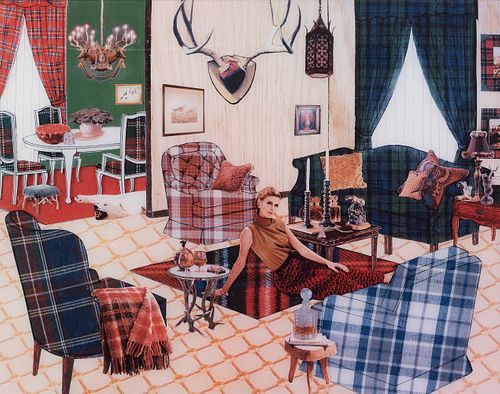LAURIE SIMMONS (Long Island, New York, 1949). "Checkered living room." The instant decorator, 2004. Flexible printing. Edition 3/5. Presents certifica
Lot 58
About Seller
Setdart Auction House
Carrer Aragó 346
Barcelona
Spain
Setdart Subastas was born in 2004 and is currently the first online art auction in Spain with solidity, prestige and reliability guaranteed by our more than 60,000 users. Setdart has a young, dynamic and enterprising team ready to successfully manage the purchase and sale of art works through custom...Read more
Categories
Estimate:
$4,000 - $5,000
Absentee vs Live bid
Two ways to bid:
- Leave a max absentee bid and the platform will bid on your behalf up to your maximum bid during the live auction.
- Bid live during the auction and your bids will be submitted real-time to the auctioneer.
Bid Increments
| Price | Bid Increment |
|---|---|
| $0 | $10 |
| $200 | $25 |
| $500 | $50 |
| $1,000 | $100 |
| $3,000 | $200 |
| $5,000 | $500 |
| $10,000 | $1,000 |
| $20,000 | $2,000 |
| $50,000 | $5,000 |
About Auction
By Setdart Auction House
Jun 17, 2021
Set Reminder
2021-06-17 06:15:00
2021-06-17 06:15:00
America/New_York
Bidsquare
Bidsquare : 19th & 20th Century Contemporary Art - Select Lots
https://www.bidsquare.com/auctions/setdart-auction-house/19th-20th-century-contemporary-art---select-lots-7081
Setdart Auction House sofia@setdart.com
Setdart Auction House sofia@setdart.com
- Lot Description
LAURIE SIMMONS (Long Island, New York, 1949). "Checkered living room." The instant decorator, 2004. Flexible printing. Edition 3/5. Presents certificate of authenticity, exhibition labels and signature on the back. Provenance: Galería Distrito Cuatro (Madrid). Measures: 76.2 x 96.5 cm; 84.1 x 104.1 cm (frame). "Plaid living Room" (2004) belongs to the Instant Decorator series, which was initiated by Simmons in 2001, with the intention of materializing his research on an interior decoration book published in 1976. This publication had different templates of domestic interiors, which allowed the reader to decorate rooms with fabric swatches and different paintings. By rescuing this "Do it by yourself" idea, the author constructed an image that echoes the aesthetics of collage, where different independent elements coexist, forming a set of great visual expressiveness. Through a domestic interior in which an elegantly dressed woman lies on the carpet, the author poses to the viewer an uncertainty about who this character is, and what she represents. The protagonist is surrounded by luxuries, and looks at the viewer suggestively, but she is alone, and her pose and dress invite her to be represented as just another piece of furniture, as an object of consumption. This representation of the woman, reflecting on her role in the social environment, was one of the first themes explored by Laurie Simmons in her works. In which she related the space of the home with the feminine, like other artists such as Martha Rosler, or Barbara Kruger, who used similar themes and techniques to the one presented here. Laurie Simmons grew up in Long Island, in an era of economic expansion that marked the beginning of material prosperity, but also gave rise to a state of conformity, characteristics that are very recurrent in the themes explored by the artist. Her career stands out for its versatility, as she works as an artist, photographer and filmmaker. After graduating from Tyler School of Art in the late 1960s and settling in New York City, Simmons began to develop her artistic side. In 1972, Simmons discovered a vintage dollhouse in the attic of a toy store in Liberty, New York, so he began making compositions with dolls, which he subsequently photographed and intervened. Most of his works make a statement about traditional gender roles, questioning them and criticizing the objectification of the person, especially women. Simmons is part of the important artistic group, The Pictures Generation, a name given to a group of artists who rose to fame in the 1970s, and which includes world-renowned artists such as Cindy Sherman, Barbara Kruger and Louise Lawler. Much of Simmons' work, like that of the aforementioned artists, is rooted in the role of women and their integration with their environment and society. In a March 2014 interview, Simmons stated, "When I picked up a camera with a group of other women, I'm not going to say it was a radical act, but we were certainly doing it in a kind of defiance or reaction to, a male-dominated world of painting." Today her work is in important collections both private and public, examples include the Queen Sofia Art Center, the Art Institute of Chicago, MoMA in New York, the National Gallery of Art in Washington, D.C., and the Los Angeles County Museum of Art, among others.
- Shipping Info
-
In-house shipping available. Please inquire at admin@setdart.com.
-
- Buyer's Premium



 EUR
EUR CAD
CAD AUD
AUD GBP
GBP MXN
MXN HKD
HKD CNY
CNY MYR
MYR SEK
SEK SGD
SGD CHF
CHF THB
THB
















